Acer PE320QK 32" Ultra HD HDR Monitor Review: A Strong FreeSync Value
Why you can trust Tom's Hardware
Grayscale, Gamma & Color
Grayscale Tracking
The PE320QK can be calibrated with precision, but only in its DCI-P3-based User mode. If you need sRGB color, you’ll have to choose the fixed mode, which is set at the factory and cannot be altered.
Our grayscale and gamma tests are described in detail here.
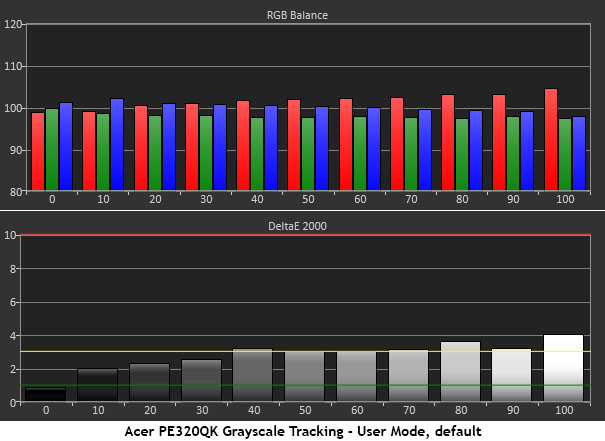
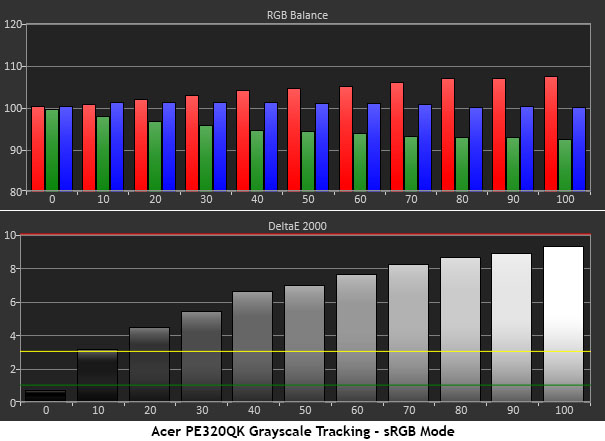
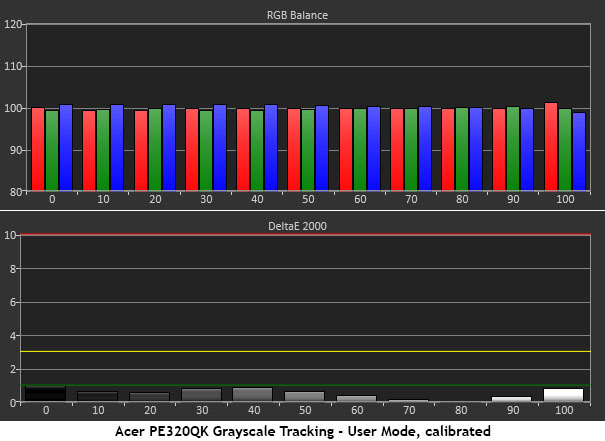
The best out-of-box grayscale tracking comes from the User mode. Here, the errors are all right around 3dE with a respectable average of 3.04dE. In the fixed sRGB mode, we were surprised to see visible errors that were higher than those stated on the included calibration data sheet. Oddly, there is no data for the other color modes, which as you can see are much more accurate. Returning to the User mode, we tweaked the RGB sliders a bit and turned Contrast down one click to achieve visually perfect tracking.
Comparisons


A 6.96dE average for sRGB is disappointing in a professional monitor. Many displays we review can provide lower errors in this test. If you’re using the PE320QK for its extended color, however, accuracy is not an issue. You don’t need to calibrate but achieving a 0.55dE average grayscale error is a nice boost to the ego.
Gamma Response

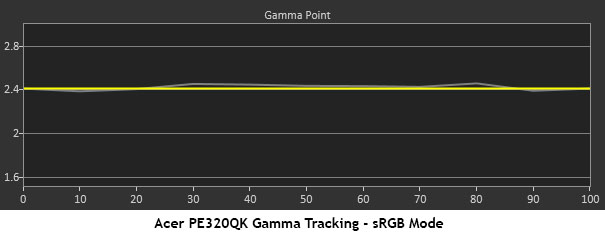

The one place where the PE320QK’s performance is perfect regardless of mode is gamma tracking. In User, you can choose from multiple presets that range from 1.8 to 2.6 in 0.2 increments. All measure exactly to spec. In sRGB and Rec.709 modes, gamma is locked to 2.4, which is correct. The only thing we wish were here is a BT.1886 option. If you’re wondering about HDR luminance, that’s covered on the next page.
Comparisons
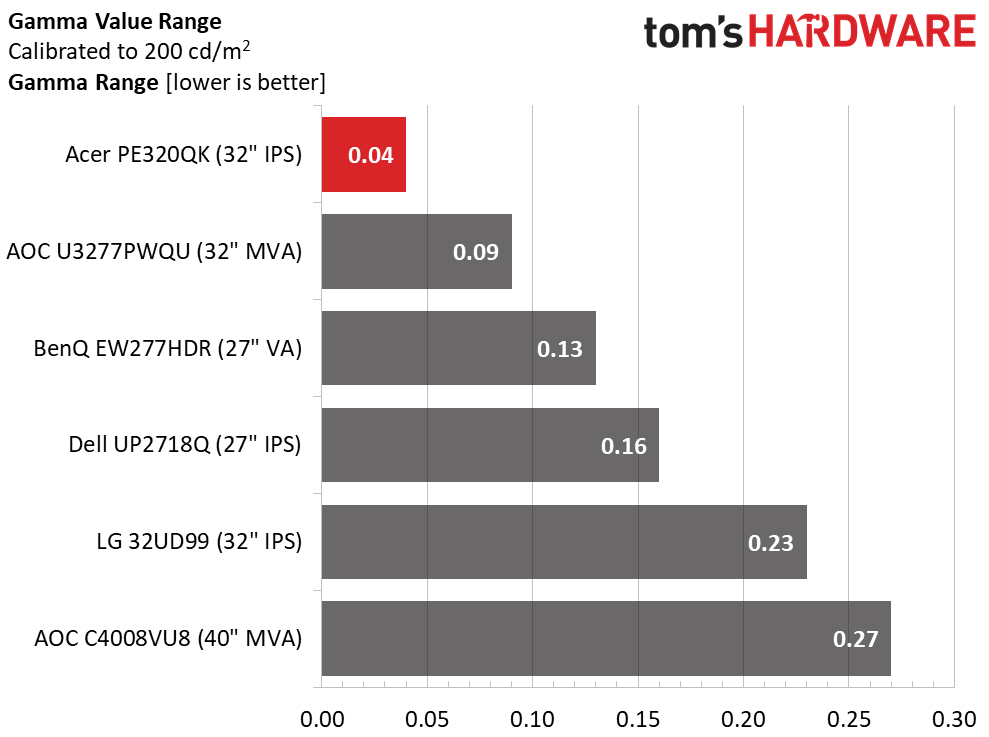
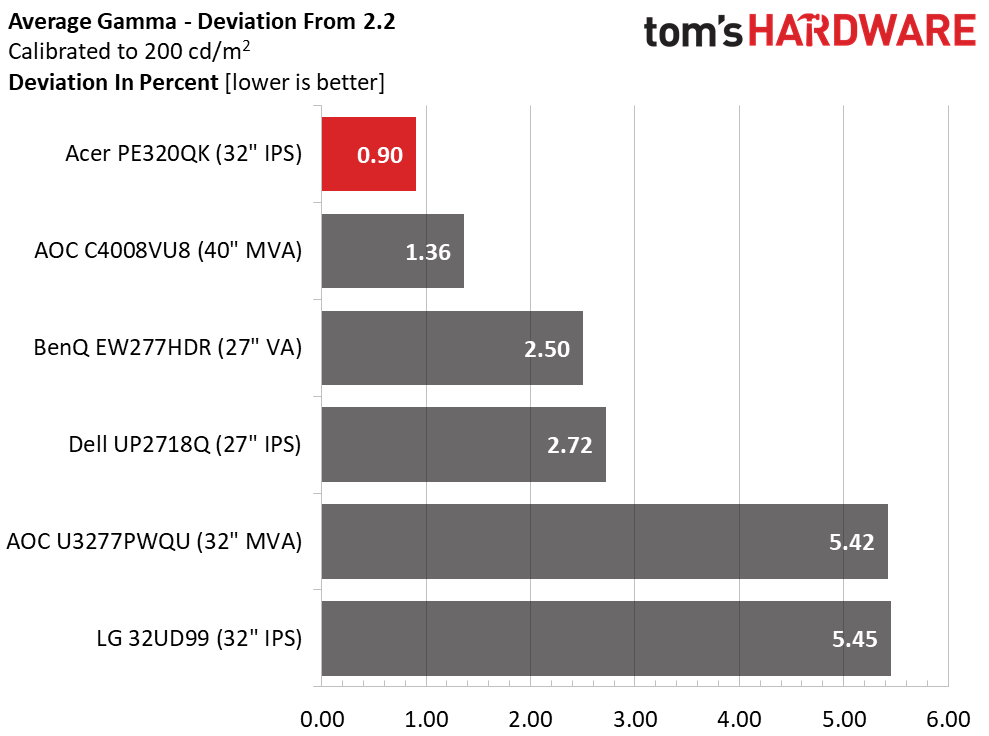
The PE320QK has the most accurate gamma we’ve ever seen in SDR mode. The above numbers represent User, which is based on the DCI-P3 gamut but sRGB delivers equal performance. Not only does this maximize perceived contrast, it ensures proper color saturation tracking, which we’ll show you now.
Color Gamut & Luminance
For details on our color gamut testing and volume calculations, please click here.
Get Tom's Hardware's best news and in-depth reviews, straight to your inbox.
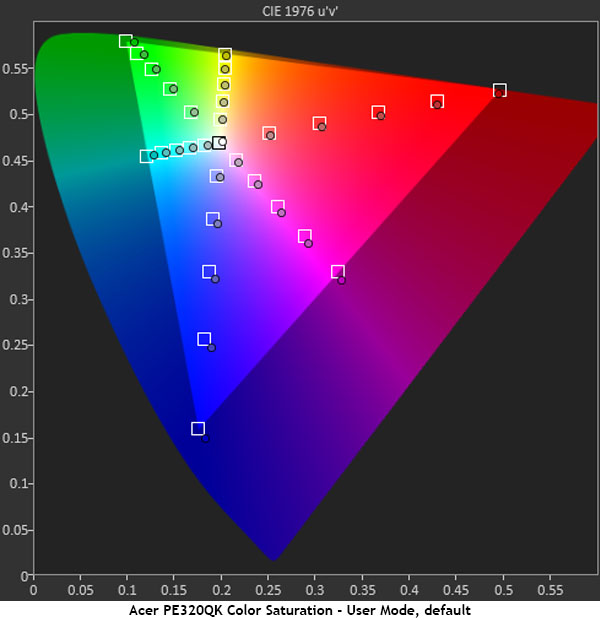
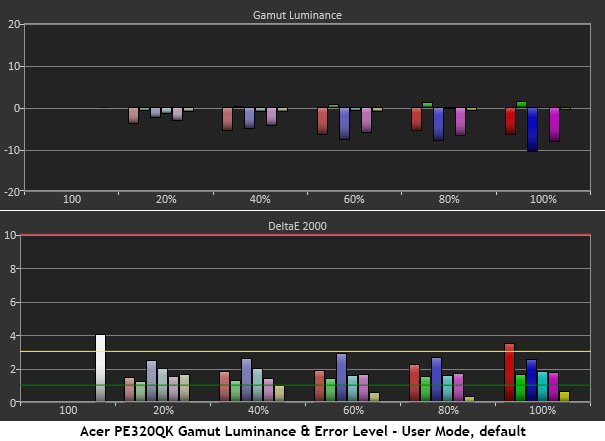
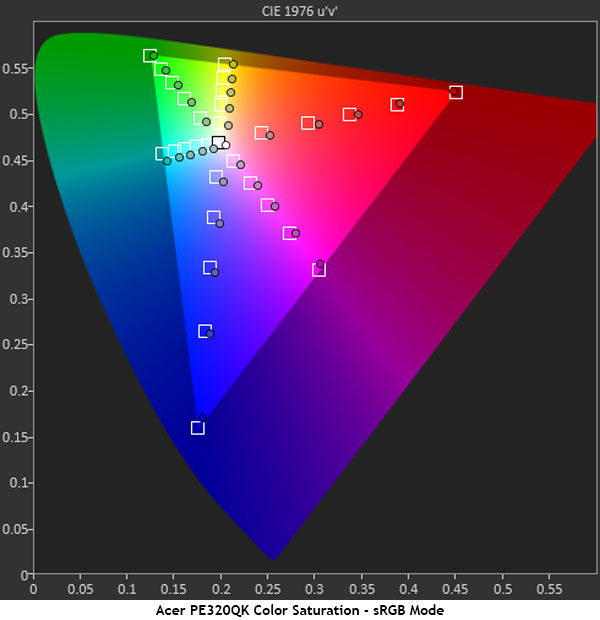

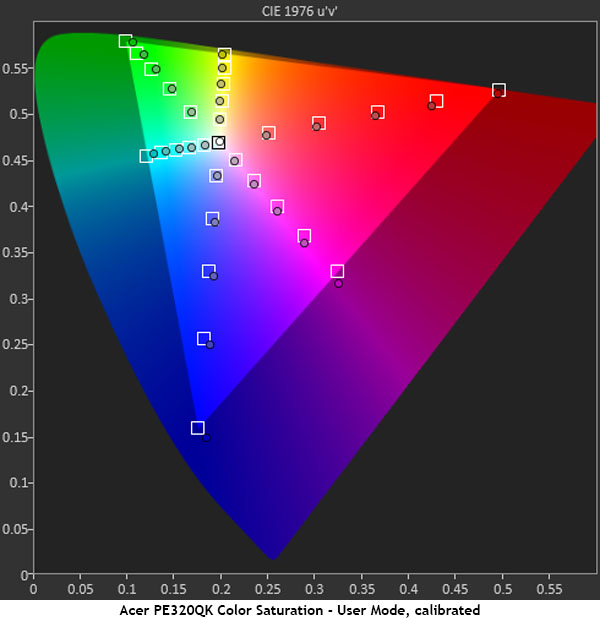

At its heart, the PE320QK is a DCI-P3 monitor with an added sRGB capability. Whether you calibrate or not, it tracks the DCI targets almost perfectly. At default settings, it sports a low 1.86dE average. That is well below the point where we’d recommend calibration. But if you decide to make the adjustments, that error drops to 1.5dE.
In sRGB mode, things are not quite as wonderful, but overall performance is good. You can see slight over-saturation in the red primary and small hue errors in the secondary colors. This could be fixed with a grayscale calibration if one were possible. Luminance levels are quite close to neutral, however, which goes a long way toward solid image quality.
Comparisons
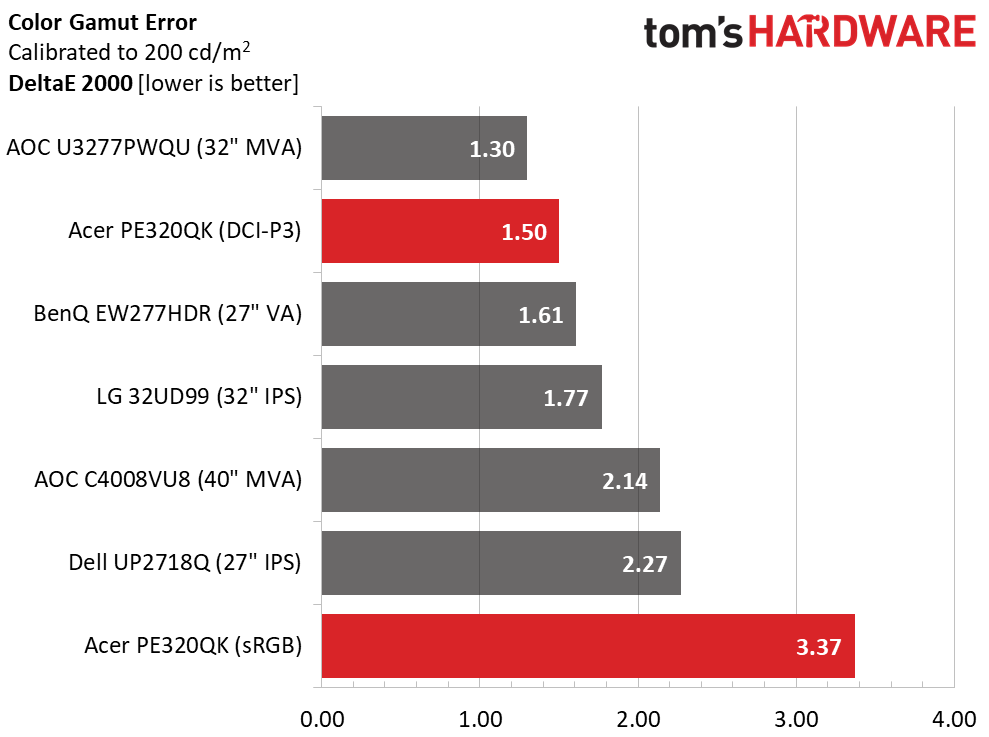
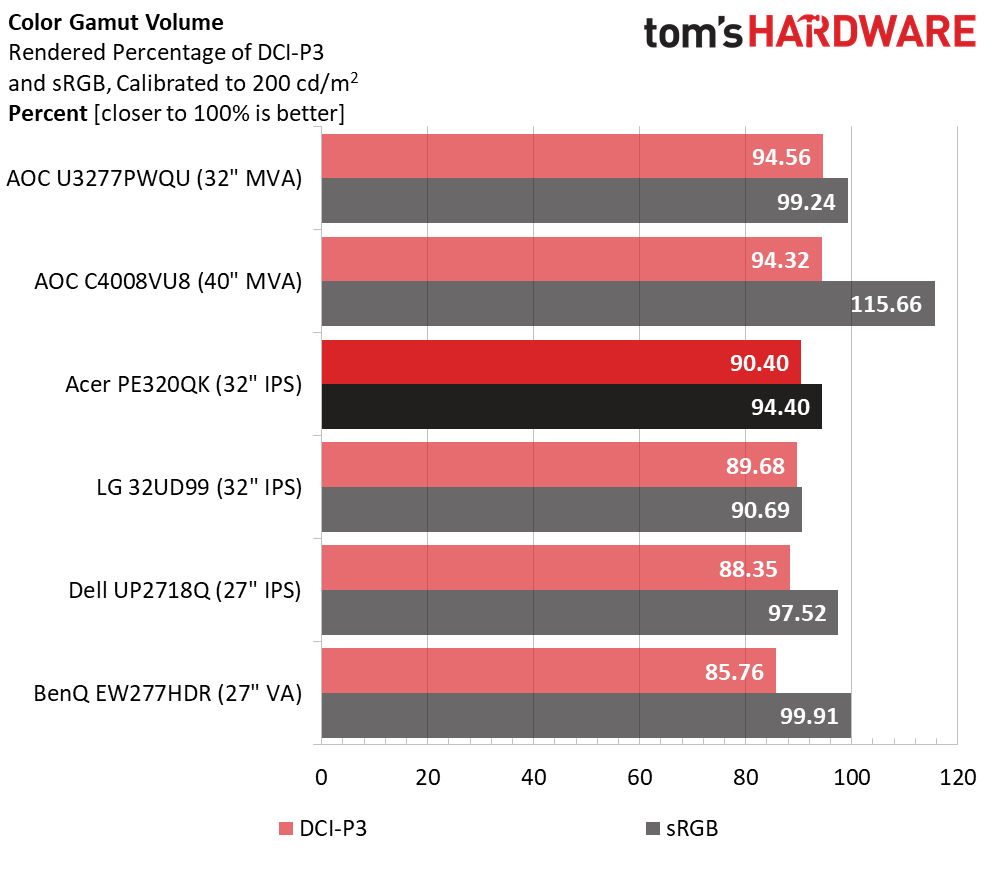
As a DCI-P3 monitor, the PE320QK is among the best we’ve tested. In sRGB mode, it’s a little less impressive. If you need that smaller gamut, there are better screens out there. But if your work requires extended color, there are few that perform this well.
For the volume test, we’re finding Adobe RGB less relevant with so much focus on Ultra HD and DCI-P3 color. Therefore, we’ve updated our chart to show that gamut along with sRGB. All the screens have selectable modes except the C4008VU8, which explains its large sRGB volume. The other monitors all manage to render nearly 100% of sRGB and between 85% and 95% of DCI. The PE320QK is right in the middle, at 90.4%. This is about as good as it gets for now. We have yet to see a display meet or exceed 100%.
MORE: Best Gaming Monitors
MORE: Best Professional Monitors
MORE: How We Test Monitors
MORE: How To Choose A Monitor
MORE: All Monitor Content
Current page: Grayscale, Gamma & Color
Prev Page Brightness & Contrast Next Page HDR Tests & Hands-on
Christian Eberle is a Contributing Editor for Tom's Hardware US. He's a veteran reviewer of A/V equipment, specializing in monitors. Christian began his obsession with tech when he built his first PC in 1991, a 286 running DOS 3.0 at a blazing 12MHz. In 2006, he undertook training from the Imaging Science Foundation in video calibration and testing and thus started a passion for precise imaging that persists to this day. He is also a professional musician with a degree from the New England Conservatory as a classical bassoonist which he used to good effect as a performer with the West Point Army Band from 1987 to 2013. He enjoys watching movies and listening to high-end audio in his custom-built home theater and can be seen riding trails near his home on a race-ready ICE VTX recumbent trike. Christian enjoys the endless summer in Florida where he lives with his wife and Chihuahua and plays with orchestras around the state.
-
Ninjawithagun Only 60Hz? No G-Sync? No Dolby Vision (only HDR 10 Plus)? No 12-bit color? Pass.Reply -
cryoburner Reply20849446 said:Only 60Hz? No G-Sync? No Dolby Vision (only HDR 10 Plus)? No 12-bit color? Pass.
It's a 4K monitor. The last I checked, high-refresh rate 4K screens aren't really a thing yet, and if we're talking about gaming (which this screen isn't really targeted toward) even a 1080 Ti will struggle to get 60 fps at max settings in many games. As for Dolby Vision and G-Sync, they are proprietary technologies that would drive up the cost of the display and be of limited use to the professional market that it's targeted toward, and the screen does support the open standard equivalent technologies to both. -
JonDol Reply20850771 said:20849446 said:Only 60Hz? No G-Sync? No Dolby Vision (only HDR 10 Plus)? No 12-bit color? Pass.
It's a 4K monitor. The last I checked, high-refresh rate 4K screens aren't really a thing yet, and if we're talking about gaming (which this screen isn't really targeted toward) even a 1080 Ti will struggle to get 60 fps at max settings in many games. As for Dolby Vision and G-Sync, they are proprietary technologies that would drive up the cost of the display and be of limited use to the professional market that it's targeted toward, and the screen does support the open standard equivalent technologies to both.
There are lots of peoples who don't care about the extra cost of those proprietary technologies but just want that such a monitor exists and that, sadly, isn't the case yet. And they care even less if a today 1080 Ti will agonize displaying those games because such a monitor is a future proof investment. Just as a reminder, the same was the case over a decade ago when the first FHD monitors came to market: the best video cards were also struggling with the max settings at that resolution...
Cheers
-
sephirotic Reply20852386 said:20850771 said:20849446 said:Only 60Hz? No G-Sync? No Dolby Vision (only HDR 10 Plus)? No 12-bit color? Pass.
It's a 4K monitor. The last I checked, high-refresh rate 4K screens aren't really a thing yet, and if we're talking about gaming (which this screen isn't really targeted toward) even a 1080 Ti will struggle to get 60 fps at max settings in many games. As for Dolby Vision and G-Sync, they are proprietary technologies that would drive up the cost of the display and be of limited use to the professional market that it's targeted toward, and the screen does support the open standard equivalent technologies to both.
There are lots of peoples who don't care about the extra cost of those proprietary technologies but just want that such a monitor exists and that, sadly, isn't the case yet. And they care even less if a today 1080 Ti will agonize displaying those games because such a monitor is a future proof investment. Just as a reminder, the same was the case over a decade ago when the first FHD monitors came to market: the best video cards were also struggling with the max settings at that resolution...
Cheers
144hz is dumb gaming gimmick.
However 60hz in this day and age is unnaceptable even for professional use. I'm tired of editing 24fps content with judderr or at lower 48hz. 75/72hz should have been the new standard for a long time now. Modern ips is perfect capable of refreshing at 12ms, even half of that full g2g without overdrive.
Monitor makers are completing neglecting their profissional and prosumer customers.
-
drajitsh I print using a photo printer. That means adobeRGB is still very very important. Also, 8 bit native means it is a enthusiast rather than pro monitor.Reply